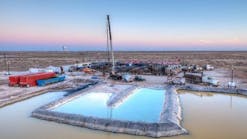Reinvestment rate, leverage, and the commodity cycle
GREGORY V. MILANO AND JINBAE KIM, FORTUNA ADVISORS, NEW YORK, NY
WHY DO EXPLORATION and production companies make more acquisitions, buy back more stock, and invest more in growing and developing their reserves when the commodity price is high and these uses of capital are at their most expensive levels? Why do they lever up at the top of the cycle when there seems to be more downside than upside? These actions seem at odds with the rational concept of "buy low and sell high." Can behavioral finance explain these seemingly irrational behaviors?
For over half a century, business school students have been trained in the efficient market hypothesis which asserts that investors cannot "beat the market" because the stock market is so efficient that share prices reflect essentially all available information at all times. In their economics classes, these students have been taught how investors always make rational decisions that are in their best self-interest. Given the volatility in the oil and gas industry, many undoubtedly wonder how efficient the market is and how rational investors are. How do we explain the apparent market inefficiency and irrational behaviors?
A few decades ago a new field of "behavioral finance" emerged with the intent of explaining why markets sometimes deviate from absolute efficiency and how our innate biases cause irrational behaviors that can influence decisions and drive markets. For example, one of many so-called irrational behaviors results from "recency bias," which explains that we often extrapolate recent events into the future. That is, if oil prices have been low, we act as if they will continue that way, and when prices are high, we act as if that will continue, too.
In addition to explaining investor actions, behavioral finance can help explain management behaviors too as executives are prone to the very same human biases as investors. When developing strategies, thoughtful management teams should consider how irrational behavior by investors and competitors can affect the market and create opportunities to capitalize on. More on this later.
Admittedly, we at Fortuna Advisors have a bit of an obsession with "buy low and sell high." Everybody should. However, in the midst of a downturn, the "recency bias" takes over, where many E&P executives aren't convinced that investing at the low end of the cycle actually works, so we decided to examine the facts, which is the perfect antidote to overcome this bias.
After the oil price peaked at $145 in mid-2008, it dropped below $100 in the fourth quarter and stayed there until the first quarter of 2011. We studied the investment record of 56 E&P companies from Q4 2008 through Q1 2011 to see if those that invested while the oil price was down fared better in the stock market.
We sorted the companies based on their Total Reinvestment Rate into high, medium, and low buckets. The Total Reinvestment Rate is defined as total capital expenditures and cash acquisitions as a percent of EBITDA. Then we examined the median total shareholder return (TSR includes share price changes and dividends) of the high, medium, and low groups during this period and for the three years that followed. These extra three years are to ensure we examined a long enough period to allow companies to realize the benefits of their investments.
During the last downturn, high reinvestment resulted in the best stock market performance over the following years. The low reinvestment group reinvested a median of 56% of their EBITDA into capital expenditures and cash acquisitions, while the medium group invested 106% and the high group invested 216%. These are big differences in the level of reinvestment and they resulted in big differences in TSR. The low, medium, and high groups exhibited median TSR of 22%, 63%, and 102%, respectively. Then we examined acquisitions and capital expenditures separately, the high reinvestment rate group also had the best median TSR in each case. So "buy low" worked last time.
There are many reasons why buying low can lead to better share price performance. Adding reserves at a low cost per barrel tends to lead to better profits when the market rebounds. Returns on capital tend to be higher due to this profit increase but also because the asset value in the denominator tends to be low. These investments tend to fuel growth, which is necessary to grow not just profit margins, but also the dollars of profit long term. And beyond the actual purchase of reserves, all sorts of drilling and other services tend to be much cheaper during a downturn too, so these economical expenditures can also benefit current and future profits and returns.
How has investment trended in the current down cycle? Total capital expenditures and cash acquisitions by E&P companies over the last 12 months (LTM) is down 58% versus June 2014, the last month oil was priced above $100. The natural question is, if it worked so well last time, why aren't E&Ps investing more during this downturn? One explanation is the recency bias discussed above. Oil prices have been down for a while so behavioral finance predicts that corporate executives will tend to behave as if the oil price will stay low indefinitely.
Another important human bias that affects behavior in down cycles is "loss aversion." Behavioral finance researchers have conducted tests showing that we tend to feel losses over twice as strongly as we feel equivalent gains. This loss aversion bias tends to manifest itself in indecision and procrastination rather than taking any sort of bold actions. So although most industry executives undoubtedly agree that future oil prices will be higher, loss aversion tends to bias them against making seemingly contrarian investments.
Financial leverage tends to exacerbate the loss aversion bias. From December 2010 through June 2014, aggregate EBITDA for the E&Ps increased 13% and yet, despite the strong cash generation over this period, net debt increased 40% to $134 billion. By the end of 2015 LTM net debt peaked over $30 billion higher, largely attributable to over $36 billion in aggregate share repurchases. Currently, aggregate net debt to LTM EBITDA is 4.7x, over four times the 1.1x in June 2014. This debt burden intensifies the conservative thinking behind the loss aversion bias, which in turn leads to the sharp reduction in investment we have witnessed.
There is one more relevant behavior bias known as "herding." People tend to find it easier to follow what others are doing, or seem to be doing, so the capital deployment strategies chosen by one group of E&Ps tends to track the choices of other E&Ps quite well. Interestingly, this bias also predicts that once a few E&Ps start investing more it will give others the signal and they are likely to increase their investments too. This herd mentality affects the investment community as well, and with this combination of managers and investors following the pack, it is easy to see how the herd mentality aggravates the commodity cycle by driving up-cycles higher and down-cycles lower.
We cannot predict future commodity prices any better than anyone else, but we can say with confidence that at some point in the future the oil price will be meaningfully higher than it is now. And at another point after that, it will be below where it is now. And then after that… you get the point. We expect there to be cycles so we recommend management teams act as if they expect cycles too.
During the next market high, recognize that although you don't know when or why a downturn will happen, you know it will happen at some point and when it does, there will be all sorts of risks and also attractive investment opportunities. So avoid the temptation to juice up your EPS growth in an up-cycle with buybacks and instead focus on reducing net debt, creating financial flexibility and building a war chest for use in the subsequent downturn, whenever it happens.
Admittedly, it's easy to say what to do during the next peak when in the midst of a downturn, but what should E&P managements do now? If your company has real questions of survivability due to having too much leverage and not enough liquidity, then maintain the extreme austerity policies you undoubtedly already are pursuing. If, on the other hand, you are one of the management teams that has adequate financial flexibility, now would seem to be a very good time to invest. Everything from acquiring reserves to exploration and development expenditures are much cheaper than they were a few years ago and it is very likely that investments now will look very impressive when looking back from a higher commodity price plateau.
For those seeking to embrace these principles, we recommend planning and decision-making be more rules-based to mitigate innate management biases. Performance measurement should be more driven by absolute results, rather than results against budgets, and should incorporate a true balance of growth and return. Those that invest more when commodity prices are low will tend to have strong growth and return improvements in the next up-cycle, which is likely to drive better TSR.
And if you do step up investment, don't become too obsessed with the immediate reaction of investors. If the market doesn't respond positively when these investments are announced, don't sweat it. Over time there will eventually be an up cycle and sound investments now will likely help fuel stronger TSR over the next three to five years. Do you think Warren Buffet worried about the stock market's reaction when he announced the investment of $34 billion to buy the Burlington and Northern Santa Fe railroad in 2009? We don't think so.
ABOUT THE AUTHORS
Gregory Milano is founder and CEO of Fortuna Advisors where he is the strategic team leader on all client engagements and leads research and product/service development aimed at clarifying the shareholder value implications of capital deployment strategies and the tradeoff between maximizing returns and investing in growth.
JinBae Kim is a Senior Associate of Fortuna Advisors, specializing in modeling the financial and shareholder value impact of strategic business decisions including organic investment, M&A, share repurchases, and dividends. He performed the research discussed in the article.





